As a parent, I’m always looking for ways to help my child feel better. When Ali started having mood swings, I knew helping him think positive was key. This was vital for his mental well-being.
I was online searching for tips to help kids feel happier one day. That’s when I found a new way to make daily life full of fun activities. These activities were aimed at making kids feel more positive and improving their emotional health.
This new approach got me really interested. I found loads of strategies for helping kids’ state of mind. There were exercises to better talk with kids, ways to teach gratitude, and methods to increase their strength mentally.
I was thrilled and committed to trying these out with Ali. We included various fun activities in our routine to improve his mental state and make him feel happy.
In the next parts, I’ll tell you about some tools and activities that really helped Ali. These strategies brightened his mood and made him more resilient and hopeful.
Key Takeaways:
- Promoting a positive mindset is crucial for boosting kids’ mental health.
- Fun activities and practical tools can be incorporated into daily routines to support children’s emotional wellbeing.
- Communication exercises, fostering gratitude, and resilience-building activities are effective in nurturing a positive mindset.
- Implementing these strategies can improve children’s mood and enhance their mental resilience and optimism.
- Stay tuned for the upcoming sections where I will share specific activities and tools for promoting positive mental health in kids.
Importance of Kids’ Mental Health Activities
Kids today face more challenges which can harm their mental health. So, making sure they feel emotionally strong and helping them handle difficulties is very important. Taking part in activities for mental health is a big step in promoting good mental health and making them resilient.
These activities help kids get to know themselves better and find ways to cope. They can figure out their feelings, see where they do well or need help, and lay a strong mental health foundation. The good effects of these steps last into their adult lives, making them happier and healthier grown-ups.
A LIST OF TOYS THAT HELPED ALI AND OUR FAMILY FINDING POSITIVITY AND HAVING FUN!
- 1- A Feelings Game for Kids That Develops Emotion Regulation and Explores Anger, Sadness, Fear and Joy https://amzn.to/4cxzjLB
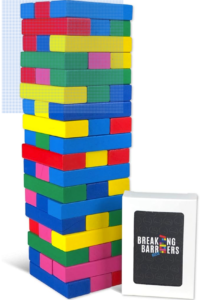
- A Little SPOT of Emotion 8 Plush Toys with Feelings Book Box Set Hardcover – Special Editionhttps://amzn.to/4eyUCP2
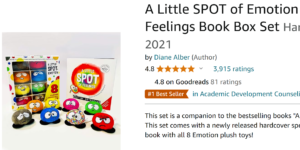
- Social Emotional Learning Activities Kids Dart Board Therapy Games for Kids | 2-in-1 Feelings Wheel Game for Familieshttps://amzn.to/3KRvi95

- Play Therapy Toyshttps://amzn.to/3XwFCuG

- The Self-Esteem BALL: The Group Activity That Makes Self-Esteem Building Fun
- https://amzn.to/3XyEwyH
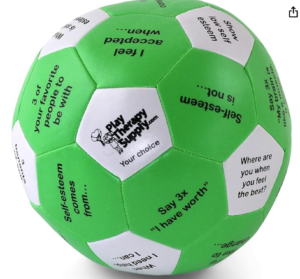
The Power of Resilience
One great thing about these mental health activities is how they boost resilience. Resilience means being able to recover from tough times and handle changes well. By doing these activities that build resilience, kids learn to tackle problems with courage, solve them, and look at things positively. These are skills that help a lot through life.
Resilience is not a fixed trait; it can be cultivated and strengthened through practice and experience.
By adding mental health activities to kids’ daily plans, family and teachers can help them face life’s tough parts more easily. They get the tools and backing they need to be strong when things get hard.
Fostering Self-Awareness and Emotional Regulation
Another key part of these activities is helping kids know and control their feelings. Learning about their emotions, expressing themselves clearly, and handling their feelings in good ways is the goal. This way, kids can learn what they need and what’s important for them.
Joining in activities like mindfulness or writing in a journal helps kids manage their feelings better. They get better at handling their emotions, which makes them better at dealing with others and feeling good about themselves.
Creating a Solid Foundation for Mental Wellness
Starting from early on, these activities pave the way for a life full of good mental health. By caring for their emotional health when they’re young, we help kids cope with stress, face challenges, and stay mentally strong. This equips them with the skills and tactics to handle life’s twists and turns, making them happier and more resilient.
AFFIRMATION CARDS! ARE A GREAT WAY OF BUILDING CONFIDENCE IN YOUR CHILD
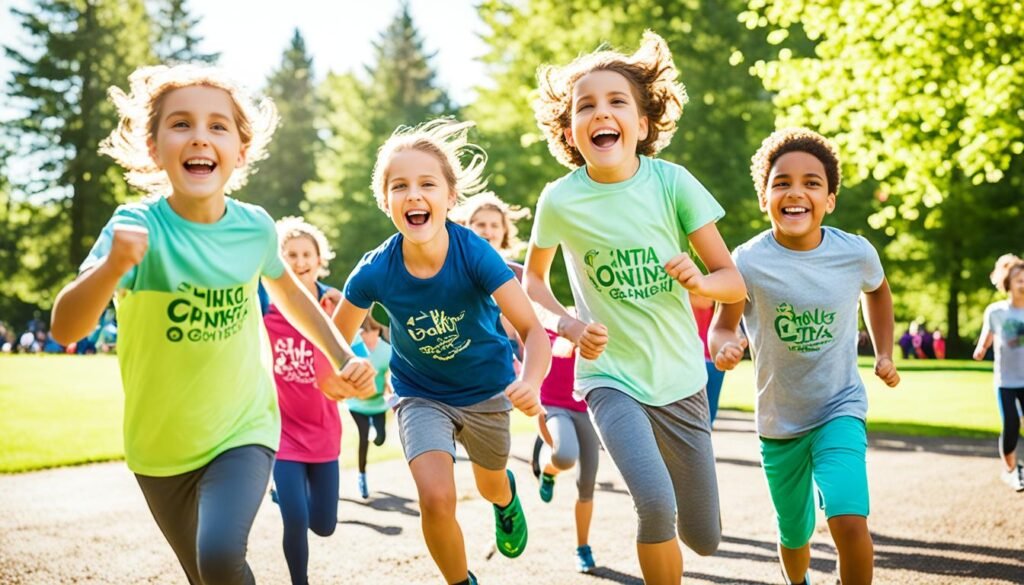
Practical Tools for Supporting Kids’ Mental Health in Schools
Schools and community groups are key to helping kids’ mental health. They offer tools and support to make a positive space for kids. These resources are for teachers, youth workers, and leaders who care about kids’ mental health.
Support for Teachers
Teachers are vital for kids’ mental health at school. They can use many tools to ensure a safe, caring classroom. This includes ways to reduce stress and teach students how to handle their feelings better.
Support for Youth Workers
Youth workers in after-school or community programs have important roles. They need special tools to help kids’ mental health. These can be activity sheets, group activities, and ways to talk about emotions.
Support for Community Organizations
Communities can be a strong support system for kids’ mental health. Together with schools and local groups, they can offer tools and programs. This might involve workshops, groups, and spreading awareness.
A Collaborative Effort
Helping kids’ mental health takes a group effort. It’s not just one person or group’s job. Schools, teachers, youth workers, and communities must work together. Sharing tips, knowledge, and what works best creates stronger support for children.
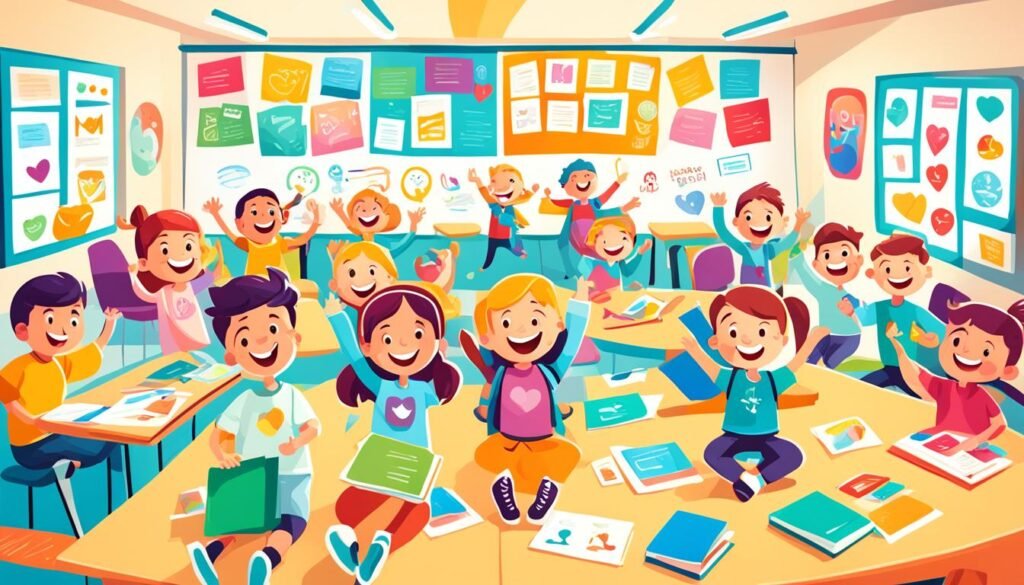
Next, let’s look at Chatterbox Chats. They focus on talking and sharing feelings to help kids’ mental health better.
Chatterbox Chats: Fostering Communication and Emotional Expression
Chatterbox chats help kids talk and share their feelings in a fun way. They create a safe zone for children to express themselves. This makes it easier for both individual and group talks about mental health.
In these chats, kids learn to talk about their feelings and connect with others. It helps them understand themselves more. Plus, it teaches them to listen actively and speak well, which helps in making strong bonds and feeling better emotionally.
Chatterbox chats work in different setups, like one-on-one with an adult or with friends. Starters and topics can make these talks more effective. Good questions can make kids think about their feelings and have deep talks.
This activity lets kids express themselves and feel heard. It gives them a chance to share their thoughts in a caring space. Chatterbox chats help children learn to talk about their emotions and how to handle tough times.
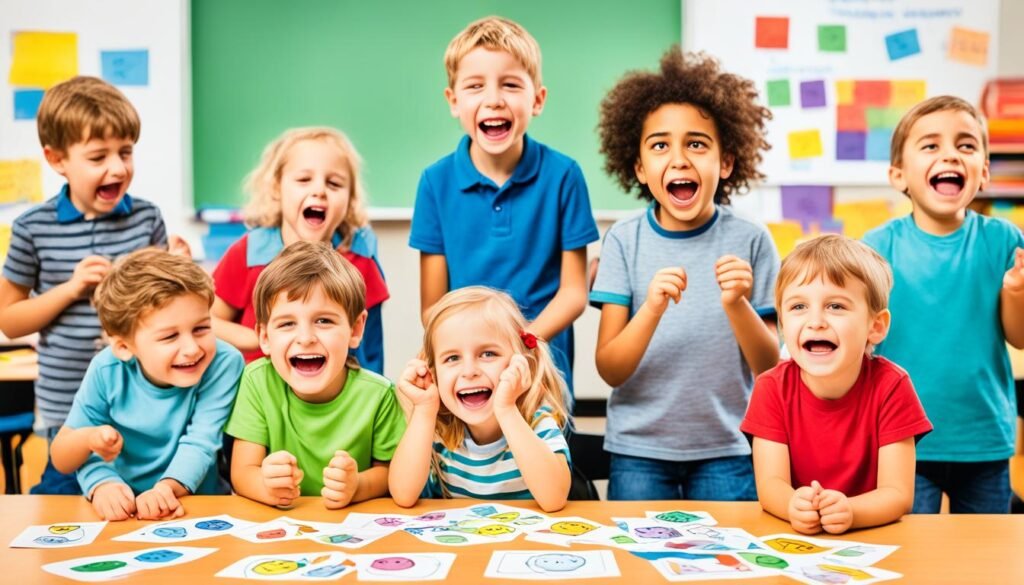
Chatterbox chats are key to better mental health for kids. They help children talk about their feelings and make connections. This makes them better at communicating and dealing with emotions.
Encouraging these talks is important for kids’ social and emotional growth. They learn important skills for maintaining good relationships and staying emotionally healthy.
Hope Clouds: Encouraging Optimism and Resilience
Hope clouds are a fun way to boost mental health in kids. They help children build resilience. Resilience is important when facing tough times. This activity encourages a positive attitude and helps kids strive for their dreams.
So, what are hope clouds? They’re colorful designs showing what kids hope for. Kids think about what they want and then draw it. This makes them believe they can reach their dreams. Hope clouds can show big career dreams, small wishes for joy, or any dreams in between.
Creating hope clouds is exciting for kids. It lets them imagine their futures. They can make their clouds unique with drawings and quotes. This makes them feel inspired and hopeful.
Hope clouds keep kids focused on their dreams. When things get hard, looking at their hope clouds can motivate them. It reminds them of what they’re working towards. This helps in difficult times.
By doing hope clouds regularly, kids become more positive. They learn to face challenges with hope. This is good for their mental health and helps them reach their goals.
Next, we’ll look at another fun activity for kids’ mental health. It’s called “How Many Positives?: Promoting Gratitude and Positive Thinking.”
How Many Positives?: Promoting Gratitude and Positive Thinking
Cultivating a positive mindset in kids is crucial. To do this, we focus on gratitude and optimism. The “How Many Positives?” exercise is a great way to achieve this. It helps kids see and be thankful for the good things in their lives.
This exercise is simple but works wonders. It just asks kids to think about their day and find the good parts. When they do this, they start to notice more good things around them. This boosts their positive thinking.
Gratitude Activities for Kids
Activities like “How Many Positives?” are great for kids’ mental health. They learn to be grateful for what they have. This makes them feel happy and positive more often.
Exercises that focus on positive thinking build resilience in kids. They learn to face challenges with a brave, hopeful heart. They get good at seeing the bright side, even in tough times.
Recognizing Blessings
The exercise helps kids see their blessings, big and small. It makes them appreciate the kindness of others and the little joys in life. This makes them emotionally stronger and improves their relationships.
Adding gratitude exercises to kids’ days helps a lot. It makes them happier and mentally healthier. A positive attitude and thankfulness help them tackle life’s ups and downs with grace and hope.
| Benefits of Gratitude Activities for Kids | Examples of Gratitude Activities |
|---|---|
| 1. Promote positive thinking and optimism | 1. Keeping a gratitude journal |
| 2. Develop resilience and coping skills | 2. Writing thank-you notes |
| 3. Enhance emotional well-being | 3. Sharing gratitude in a daily conversation |
| 4. Strengthen relationships and foster empathy | 4. Creating a gratitude jar or wall |
| 5. Increase overall happiness and life satisfaction | 5. Engaging in acts of kindness |
Teaching kids gratitude is a gift for their future. The “How Many Positives?” exercise helps them form a habit of seeing the good. It makes them better at facing life’s challenges with a positive mind and grateful heart.
Star Qualities: Building Self-esteem and Resilience
It’s crucial to help kids build both self-esteem and resilience. Encouraging kids to see their star qualities can do wonders. This means pointing out their strengths, talents, and what they’ve accomplished.
This way, kids start seeing what makes them stand out. It’s not just about feeling good about themselves. They also learn to believe in what they can do.
There are lots of fun things kids can do to boost their self-esteem. Here are a few:
- First, there’s positive affirmations. Kids can write down things like, “I am talented” or “I am resilient.” These notes help remind them of their good points and grow confidence.
- Next, there’s the strengths and talents collage. Children can make a collage to show off what they’re good at. They can use pictures from magazines or print stuff off the internet that shows who they are.
- Star journals are another cool idea. In these journals, kids can write about their wins, progress, and tough moments where they showed they’re strong. This helps them remember how awesome they are.
Adding these activities to a kid’s routine can really make a difference. It teaches them to face problems with a can-do attitude. Plus, it helps kids find value in who they are and what makes them special. This is how we empower them.
Drawing Your Emotions: Expressing Feelings Through Art
Drawing your emotions is a powerful way to express how you feel. It allows kids to understand their feelings better. They assign colors to their emotions and use them in their art.
This helps children get to know themselves. They explore their feelings and get better at knowing why they feel a certain way.
This activity is also a safe way for kids to talk without using words. Sometimes words alone can’t show how we feel. Art helps express those deeper feelings in a clear way.
Kids learn a lot about themselves through art. They can show happy moments with bright colors, or use dark colors for sad times. Each piece of art shows how they feel inside.
Creating art helps kids feel more in control of their emotions. Seeing their feelings on paper helps them understand those feelings better. They learn to name their emotions right, which is a big step in knowing themselves.
Drawing their feelings makes kids think deeply about their emotions. They learn to see what causes these feelings and how to handle them. This thinking helps build their ability to cope with strong emotions.
Kids’ creativity blooms when they draw their emotions. They show their personal views and experiences in their art. They become more confident and curious through experimenting with art.
Drawing emotions is more than just about art. It helps kids become more caring and understanding. This makes them better at supporting others and building good relationships.
Artistic Expression through Drawing Your Emotions
Artistic expression is key to understanding and dealing with feelings. Drawing your emotions is a simple yet powerful way for children to reflect on their emotional world. It leads them to learn more about themselves.
Relaxation Techniques: Managing Stress and Anxiety
It’s crucial to teach kids relaxation techniques for handling stress and anxiety. By giving them ways to relax, they can deal with life’s challenges better. This makes them stronger and more resilient.
One of the best methods is deep breathing. Kids can breathe in slowly through their nose and out through their mouth. This makes their bodies relax, slowing their heart rate and easing tension. It’s a simple skill they can use anywhere to lower stress.
Doing calming activities also helps kids find peace. Things like coloring, listening to calm music, or doing yoga can shift their focus. They bring a quiet moment in a busy day, helping kids find a peaceful place within themselves.
Making relaxation techniques part of a child’s daily life is very beneficial. They learn to control their emotions and keep a healthy mind by using these skills regularly.
The Importance of Teaching Relaxation Techniques
In today’s world, kids deal with a lot of stress, from school to friends. Learning relaxation techniques gives them the power to face these issues and look after their mental health.
These skills don’t just help kids now; they’re tools for life. Kids who know how to relax do better in many ways. They’re happier, focused, and face challenges better as they grow.
Relaxation techniques are key to helping kids control their feelings and find peace within. Including these practices in their daily life can make a big difference. It helps them stay positive and strong, no matter what life throws their way.
Help your child manage stress and anxiety by teaching them relaxation techniques. Valuable skills like deep breathing and calming activities can be with them for life. These are important for their mental well-being.
Connecting with Nature: Scavenger Hunts and Outdoor Exploration
Outdoor activities are key for kids’ mental health. They take a break from screens and find joy in nature. Scavenger hunts are a fun way to get to know the outdoors.
These hunts make children observe more and enjoy nature. They find items and do tasks outside. This activity improves their exploration skills and makes them happier.
“Connecting with nature benefits children as it allows them to engage all their senses. It provides a sanctuary away from the pressures of daily life and helps them develop a deeper appreciation for the world around them.”
Scavenger hunts challenge kids to think and solve problems outside. They visit different places and look for items or clues. This helps them think better and love the Earth.
Nature walks and hunts make children feel good. They spend time outside, which makes them calm and happy. It’s a break from stress and a chance to love nature more.
The Key Benefits of Nature Exploration and Scavenger Hunts Include:
- Improved mood and well-being
- Reduced stress and anxiety
- Increased physical activity
- Enhanced cognitive skills
- Development of a sense of wonder and appreciation for nature
Parents and teachers can help kids grow by adding nature activities to their day. These activities help children love nature and stay curious. They learn about plants, animals, and the Earth.
So, plan a scavenger hunt or a nature walk for your kids. It’s more than fun; it’s vital for their health and happiness.
| Awesome Scavenger Hunt Ideas for Kids: | Age Group |
|---|---|
| 1. Nature Bingo | 3-5 years old |
| 2. Alphabet Scavenger Hunt | 5-8 years old |
| 3. Photo Scavenger Hunt | 8-12 years old |
| 4. Animal Tracks Hunt | 10-14 years old |
Conclusion
Fostering a good mindset is key for kids’ mental health. It’s important for their well-being and future success. Using practical activities and strategies can boost kids’ awareness of their emotions. This way, they can think more positively and become stronger when facing challenges.
Activities like Chatterbox Chats and Hope Clouds let kids express how they feel. They learn to talk about their emotions and become more hopeful. Teaching gratitude and boosting their self-esteem with methods like How Many Positives? and Star Qualities is also helpful.
Activities that include drawing emotions and relaxing help manage stress. Going on outdoor adventures, like scavenger hunts, is beneficial too. It improves children’s health and makes them feel better emotionally.
By doing these activities with kids, parents and teachers can help them be happier. It enhances their mood and mental health. It’s an investment in our kids’ future success and happiness. This is how we can build a healthier, happier generation.
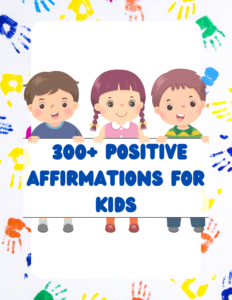


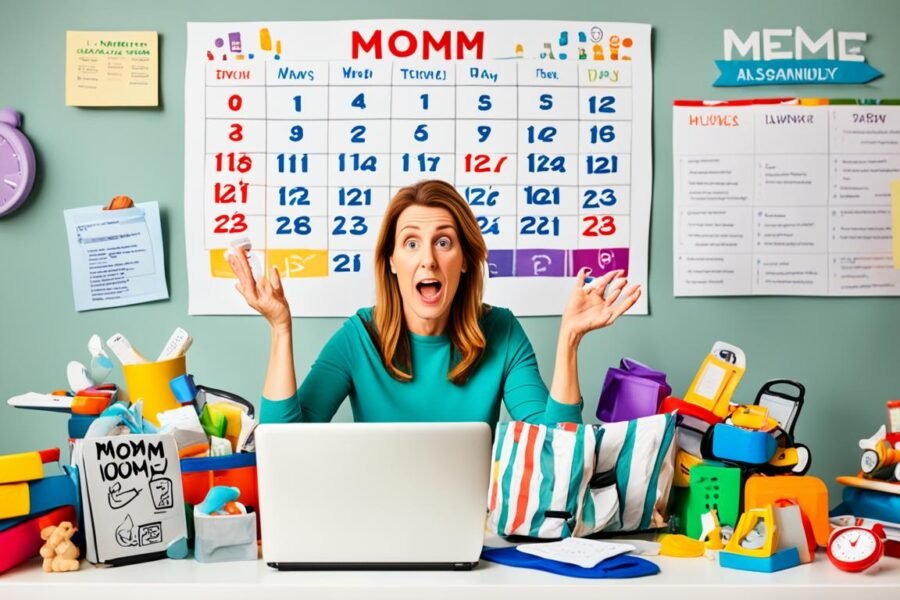
Leave a Reply